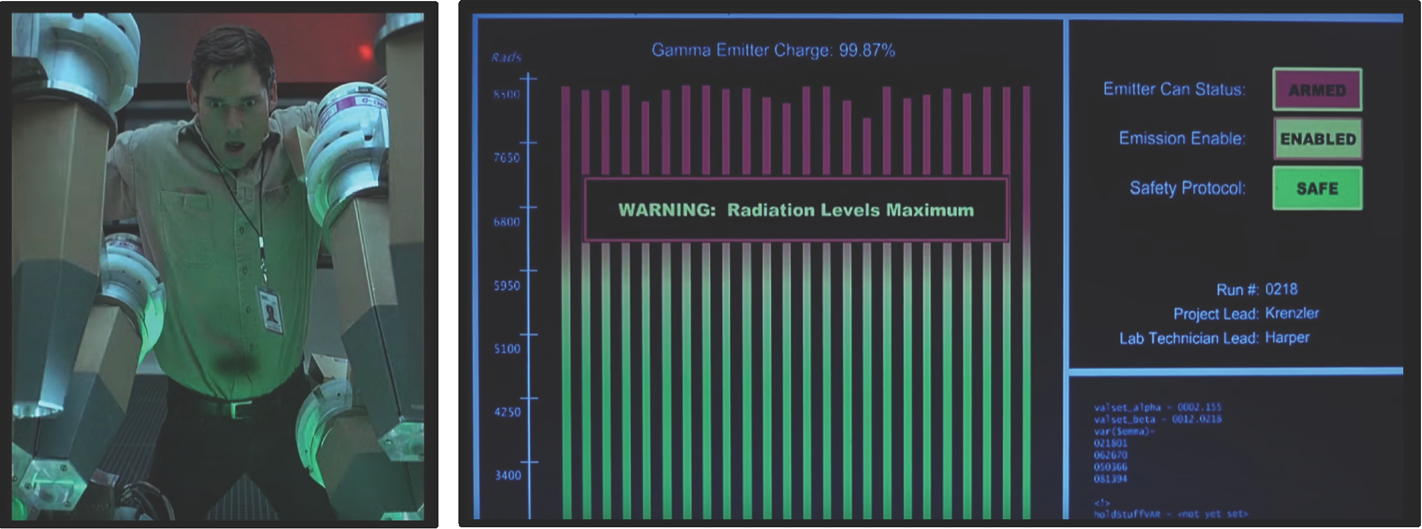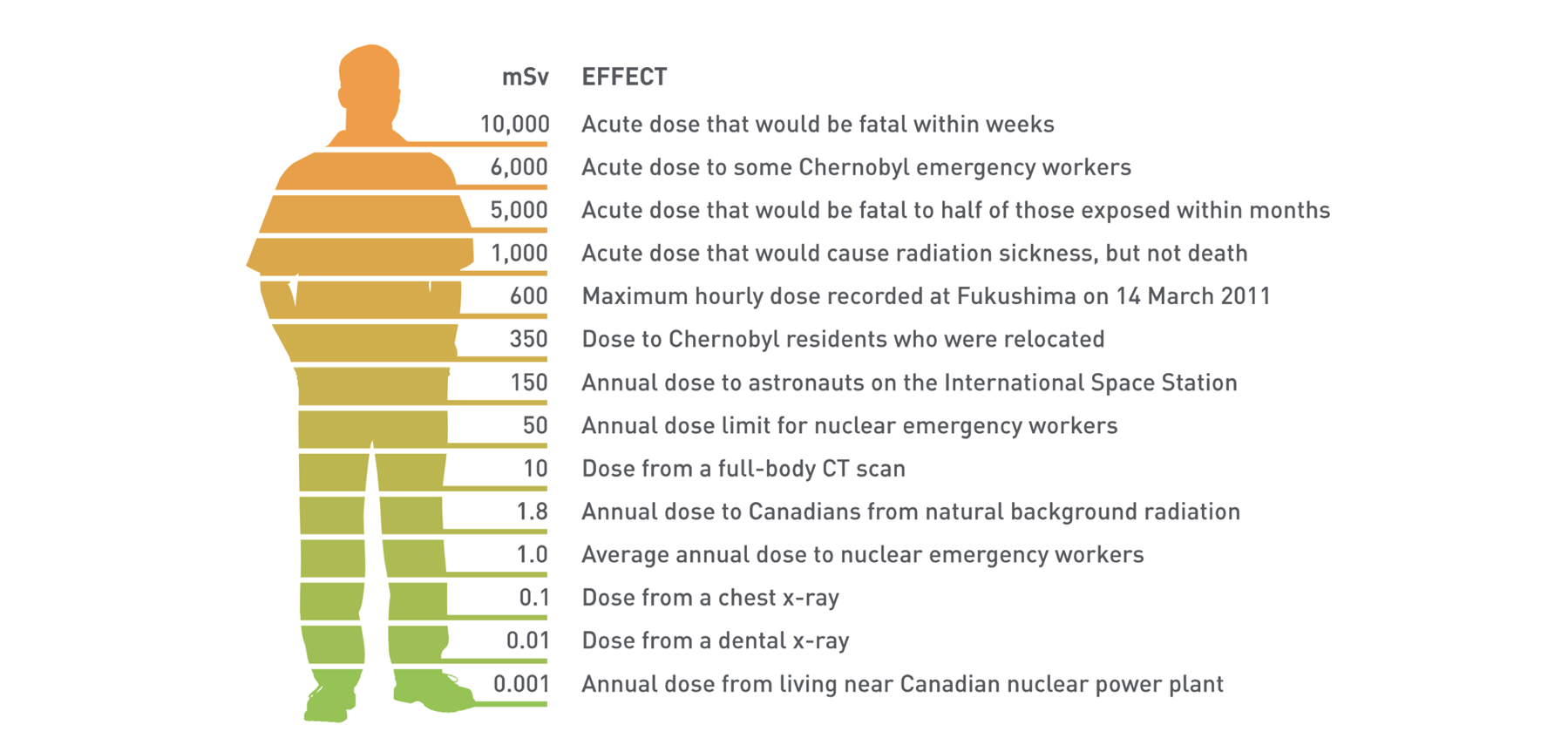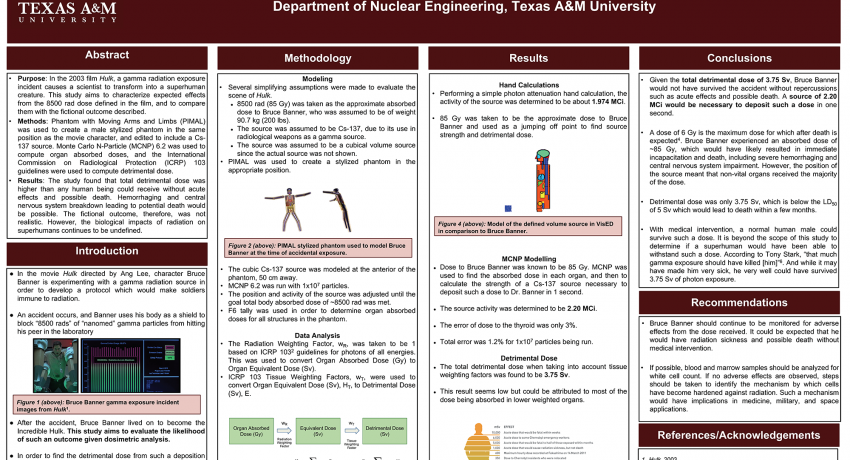Poster
Cailin O'Connell, Thomas Cuthbert
Department of Nuclear Engineering, Texas A&M University
Abstract
- Purpose: In the 2003 film Hulk, a gamma radiation exposure incident causes a scientist to transform into a superhuman creature. This study aims to characterize expected effects from the 8500 rad dose defined in the film and to compare them with the fictional outcome described.
- Methods: Phantom with Moving Arms and Limbs (PIMAL) was used to create a male stylized phantom in the same position as the movie character, and edited to include a Cs- 137 source. Monte Carlo N-Particle (MCNP) 6.2 was used to compute organ absorbed doses, and the International Commission on Radiological Protection (ICRP) 103 guidelines were used to compute detrimental dose.
- Results: The study found that the total detrimental dose was higher than any human being could receive without acute effects and possible death. Hemorrhaging and central nervous system breakdown leading to potential death would be possible. The fictional outcome, therefore, was not realistic. However, the biological impacts of radiation on superhumans continues to be undefined.
Introduction
- In the movie Hulk directed by Ang Lee, the character Bruce Banner is experimenting with a gamma radiation source in order to develop a protocol that would make soldiers immune to radiation.
- An accident occurs, and Banner uses his body as a shield to block "8500 rads" of "nanomed" gamma particles from hitting his peer in the laboratory.

Figure 1 (above): Bruce Banner gamma exposure incident images from Hulk.1 Figure 1 (above): Bruce Banner gamma exposure incident images from Hulk.1 - After the accident, Bruce Banner lived on to become the Incredible Hulk. This study aims to evaluate the likelihood of such an outcome given dosimetric analysis.
- In order to find the detrimental dose from such a deposition and resulting effects, MCNP 6.2 will be used to model the organ absorbed dose, equivalent dose, and finally detrimental dose received by Bruce Banner in the incident. PIMAL will be used to generate the input deck.
- The units given in the film were of dose, not source activity. A rad is a unit of organ absorbed dose, which is an energy deposition per mass, specifically 0.01 Joules per kilogram of matter.
Methodology
Modeling
- Several simplifying assumptions were made to evaluate the scene of Hulk.
- 8500 rad (85 Gy) was taken as the approximate absorbed dose to Bruce Banner, who was assumed to be of weight 90.7 kg (200 Ibs).
- The source was assumed to be Cs-137, due to its use in radiological weapons as a gamma source.
- The source was assumed to be a cubical volume source since the actual source was not shown.
- PIMAL was used to create a stylized phantom in the appropriate position.

Figure 2 (above): PIMAL stylized phantom used to model Bruce Banner at the time of accidental exposure. - The cubic Cs-137 source was modeled at the anterior of the phantom, 50 cm away.
- MCNP 6.2 was run with 1x107 particles.
- The position and activity of the source were adjusted until the goal total body absorbed dose of ~8500 rad was met.
- F6 tally was used in order to determine organ absorbed doses for all structures in the phantom.
Data Analysis
- The Radiation Weighting Factor, WR, was taken to be 1 based on ICRP 1032 guidelines for photons of all energies. This was used to convert the Organ Absorbed Dose (Gy) to Organ Equivalent Dose (Sv).
- ICRP 103 Tissue Weighting Factors, WT, were used to convert Organ Equivalent Dose (Sv), HT, to Detrimental Dose (Sv), E.

Figure 3 (above): Dose conversion process for radiation and tissue weighting factors.3 - The resulting Detrimental Dose was evaluated for acute and long term exposure effects given the current status of the literature, including with medical intervention.
Results
Hand Calculations
- Performing a simple photo attenuation hand calculation, the activity of the source was determined to be about 1.974 MCi.
- 85 Gy was taken to be the approximate dose to Bruce Banner and used as a jumping-off point to find source strength and detrimental dose.

Figure 4 (above): Model of the defined volume source in VisED in comparison to Bruce Banner.
MCNP Modeling
- Dose to Bruce Banner was known to be 85 Gy. MCNP was used to find the absorbed dose in each organ, and then to calculate the strength of a Cs-137 source necessary to deposit such a dose to Dr. Banner in 1 second.
- The source activity was determined to be 2.20 MCi.
- The error of the dose to the thyroid was only 3%.
- Total error was 1.2% for 1x107 particles being run.
Detrimental Dose
- The total detrimental dose when taking into account tissue weighting factors was found to be 3.75 Sv.
- This result seems low but could be attributed to most of the dose being absorbed in lower weighted organs.

Figure 5 (above): Radiation doses (mSv) and subsequent effects.5
Conclusions
- Given the total detrimental dose of 3.75 Sv, Bruce Banner would not have survived the accident without repercussions such as acute effects and possible death. A source of 2.20 MCi would be necessary to deposit such a dose in one second.
- A dose of 6 Gy is the maximum dose for which after death is expected.4 Bruce Banner experienced an absorbed dose of ~85 Gy, which would have likely resulted in immediate incapacitation and death, including severe hemorrhaging and central nervous system impairment. However, the position of the source meant that non-vital organs received the majority of the dose.
- The detrimental dose was only 3.75 Sv, which is below the LD50 of 5 Sv which would lead to death within a few months.
- With medical intervention, a normal human male could survive such a dose. It is beyond the scope of this study to determine if a superhuman would have been able to withstand such a dose. According to Tony Stark, "that much gamma exposure should have killed [him]."6 And while it may have made him very sick, he very well could have survived 3.75 Sv of photon exposure.
Recommendations
- Bruce Banner should continue to be monitored for adverse effects from the dose received. It could be expected that he would have radiation sickness and possible death without medical intervention.
- If possible, blood and marrow samples should be analyzed for white cell count. If no adverse effects are observed, steps should be taken to identify the mechanism by which cells have become hardened against radiation. Such a mechanism would have implications in medicine, military, and space applications.
References/Acknowledgements
- Hulk. 2003.
- J. Valentin, The 2007 recommendations of the International Commission on Radiological Protection. Orlando: Elsevier, published for the International Commission on Radiological Protection, 2007.
- S. Dewji. Detrimental Dose. 2019.
- J. E. Turner, Atoms, radiation, and radiation protection. Weinheim: Wiley-VCH, 2010.
- Radiation Doses And Effects. Canadian Nuclear Association. 2015.
- The Avengers. 2012.
Authors
 Cailin O'Connell is a first-year medical student in the EnMed program, a dual MD/MEng, at Houston Methodist Hospital in collaboration with the Texas A&M Colleges of Medicine and Engineering. Raised in Missouri City, Texas, her proximity to the Texas Medical Center sparked an interest in medicine early on. She completed her Bachelor of Science in Nuclear Engineering at Texas A&M University in 2019, where she focused on health physics and radiation biology.
Cailin O'Connell is a first-year medical student in the EnMed program, a dual MD/MEng, at Houston Methodist Hospital in collaboration with the Texas A&M Colleges of Medicine and Engineering. Raised in Missouri City, Texas, her proximity to the Texas Medical Center sparked an interest in medicine early on. She completed her Bachelor of Science in Nuclear Engineering at Texas A&M University in 2019, where she focused on health physics and radiation biology.
 Thomas Cuthbert recently graduated from Texas A&M University with a major in Nuclear Engineering and a minor in Radiological Health. Since graduation, he has been working as a summer fellow at the National Cancer Institute in Maryland, conducting a variety of research projects. In July however, he will begin pursuing my Doctor of Medical Physics degree at UT Health in San Antonio with plans to graduate and become a practicing Medical Physicist in 2023!
Thomas Cuthbert recently graduated from Texas A&M University with a major in Nuclear Engineering and a minor in Radiological Health. Since graduation, he has been working as a summer fellow at the National Cancer Institute in Maryland, conducting a variety of research projects. In July however, he will begin pursuing my Doctor of Medical Physics degree at UT Health in San Antonio with plans to graduate and become a practicing Medical Physicist in 2023!
- Log in to post comments

